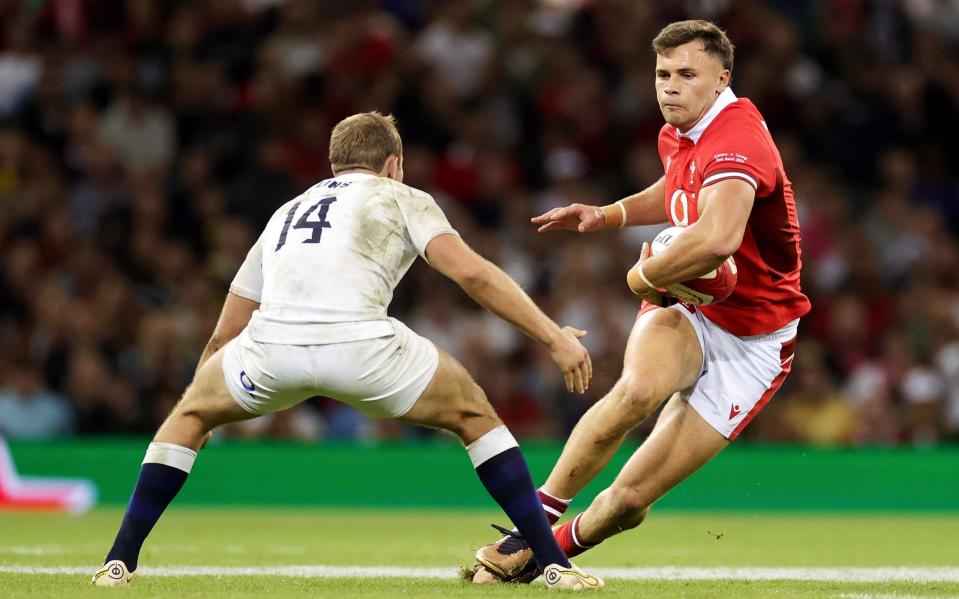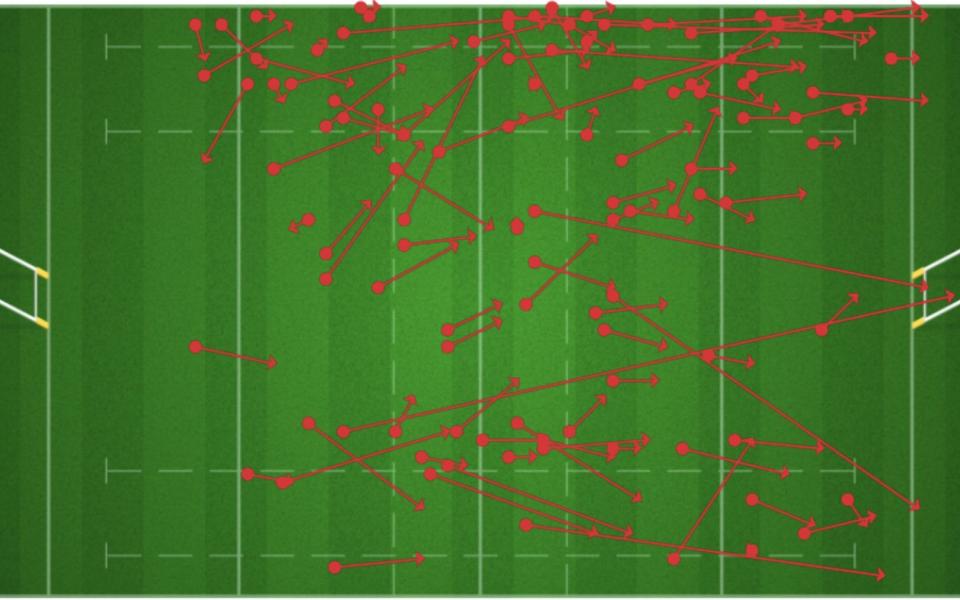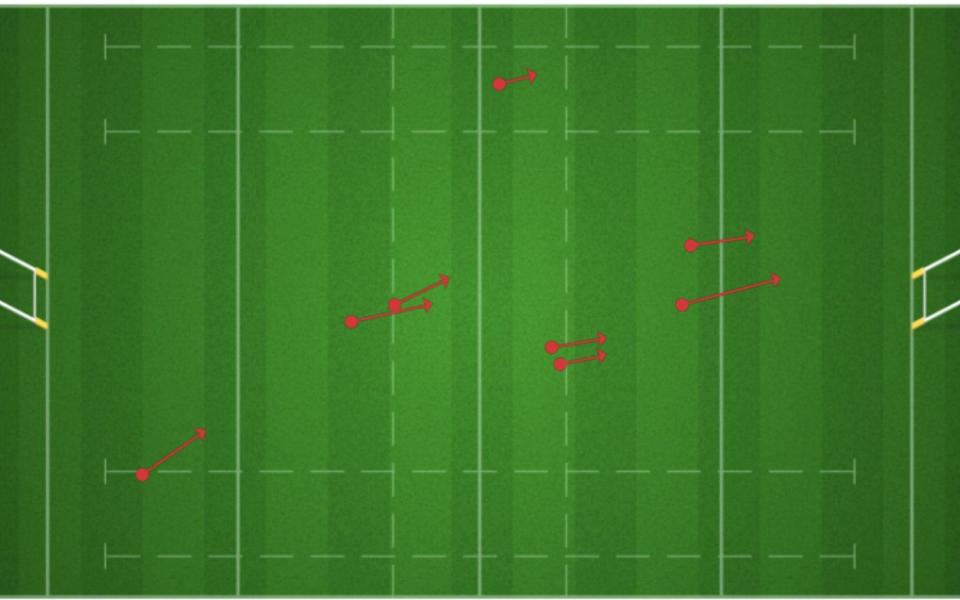Warren Gatland is trying to turn Mason Grady into the next Jamie Roberts – but it is a risk

It is a mark of where Wales are that Mason Grady’s role might not be in the top five most curious aspects of their team to face Australia in Sydney.
Warren Gatland has brought back Liam Williams, now of Kubota Spears Funabashi Tokyo Bay, at full-back. Josh Hathaway, the 20-year-old Gloucester wing, gets a debut on one wing. At fly-half, Ben Thomas will make a maiden Test start ahead of Sam Costelow.
Archie Griffin and Harri O’Connor, the two tighthead props, boast three caps between them. Among the replacements is Cory Hill, the lock who withdrew from World Cup preparations 12 months ago to take up an offer from Secom Rugguts, a club in Japan’s third tier.
Grady, a 22-year-old prospect with an exciting future, who bagged eight tries for Cardiff during the United Rugby Championship last term, will wear 12 for the second time in a professional match. The first was a fortnight ago against the Springboks.
Gatland is renowned for resourcefulness. Some 16 years back, Jamie Roberts was whisked into midfield in a bid to control the gain-line. The decision paid off handsomely, for a decade to come. Despite that happy precedent, and even though many believe we can overthink shirt numbers, there is nervousness about Grady’s switch.
‘Mason isn’t a north-south rugby player’
“I gave Mason his first start at club level,” says Richie Rees, who left the Cardiff coaching team at the end of last season to become director of the sports academy at Haberdashers’ Monmouth School.
“For me, Mason isn’t a north-south rugby player. He’s an exceptional, exceptional athlete, but everything is a bit off-line with him, which means you need to give him that little bit more time and space, a little bit of movement so that the defence isn’t on top of him. There’s a reason why he hadn’t started a professional game at 12 before the South Africa game.
“You have to get him that little bit wider out. He’s explosive, he’s got long limbs, so his fends are strong and his late footwork is good for a big guy. It’s harder to bring that in if he’s just going north-south.”
Rees explains how Cardiff endeavoured to put Grady, used at outside centre and wing, into wide positions. This is demonstrated by carry maps of the latter’s URC season (pictured below). For one try against the Stormers, the 6ft 5in runner was stationed at the front of a line-out before arcing around to crash over from a clever peel move.

“Mason’s metres made are often outside the middle of the field, within the 15-metre channels,” adds Rees, the former Wales scrum-half. “This is just my personal opinion, I don’t see him as a 12. I think he has Lions potential as a 13 and a winger. I just don’t see that as a 12, personally.”
In last month’s meeting between the Six Nations wooden spooners and the world champions at Twickenham, Wales fought hard enough to be within a point at half-time and frustrated the Springboks in the third quarter. Eventually, though, South Africa pulled away to win a scrappy affair.
Grady, alongside Owen Watkin at outside centre, was primarily sent into heavy traffic as a first-phase focal point. There were hints of fluidity, with the centres swapping for a first-half scrum play that saw Costelow chip over the top. Grady also migrated wide for one kick-return, but was only found with a forward pass from Watkin. A return of 19 metres from eight carries (pictured below) reflected Grady’s limited impact.

Roberts believes midfield is the most important area for this Wales side, because it will shape their tactical direction. Grady, says the veteran of 94 caps and two British and Irish Lions tours, will have to learn quickly.
“Warren is a pretty stubborn fella who will always back his instincts,” Roberts says. “When he makes a decision, he tends to stick by it and the continuity in midfield with Mason and Owen will help a new fly-half in Ben Thomas.
“Mason is one the most gifted athletes we’ve had for a while. His speed and his power are unmatched across the Wales back line, but I want to see more of Wales manufacturing attacking positions where he is running onto the ball at pace. It’s all well and good giving him the ball. Doing that with a standing start is pointless.
“I’d love to see Mason Grady hitting the ball at 100mph going towards soft shoulders on the advantage line. It’s up to Warren and Alex King, the attack coach, to create situations on the pitch where he’s doing that...because he can be super destructive. If he is going to thrive in that position, he can’t just be shipped the ball and asked to work a miracle in front of two or three defenders.”
‘Mason’s super-strengths are his physicality and power’
Renowned as a defensive general during a glittering career, Roberts also underlines the nuances that Grady will need to appreciate at inside centre. These include an awareness of how to maintain width in the defensive line, by resisting any urge to bite onto decoy runners or by bouncing out of the tackle area as quickly as possible.
Rees, incidentally, would have started Grady at outside centre with Thomas at 12 beyond Costelow. There is still scope to field that combination against Australia, with Costelow and Nick Tompkins among the replacements. Joe Schmidt has plumped for a pairing of Hunter Paisami and Josh Flook. While the latter is uncapped, the Wallabies centres are an established duo at the Reds.
Grady, like Roberts and then George North, who was moved from wing to outside centre, is the subject of an intriguing experiment. Leveraging his rare assets must be a priority for Wales.
“You have to run a race to suit the athletes you’ve got,” Rees finishes. “Mason’s super-strengths are his physicality and power in attack and his ability to beat defenders in one-on-one situations. Give him the best chance to do that.”
Australia v Wales
10.45am, Saturday, July 6
Allianz Stadium, Sydney
Live on Sky Sports
Australia team: Tom Wright; Andrew Kellaway, Josh Flook, Hunter Paisami, Filipo Daugunu; Noah Lolesio, Jake Gordon; James Slipper, Matt Faessler, Taniela Tupou, Jeremy Williams, Lukhan Salakaia-Loto, Liam Wright (captain), Fraser McReight, Rob Valetini. Replacements: Billy Pollard, Isaac Kailea, Allan Alaalatoa, Angus Blyth, Charlie Cale, Tate McDermott, Tom Lynagh, Dylan Pietsch.
Wales team: Liam Williams; Josh Hathaway, Owen Watkin, Mason Grady, Rio Dyer; Ben Thomas, Ellis Bevan; Gareth Thomas, Dewi Lake, Archie Griffin, Christ Tshiunza, Dafydd Jenkins, Taine Plumtree, Tommy Reffell, Aaron Wainwright. Replacements: Evan Lloyd, Kemsley Mathias, Harri O’Connor, Cory Hill, James Botham, Kieran Hardy, Sam Costelow, Nick Tompkins.

 Yahoo Sport
Yahoo Sport 






































